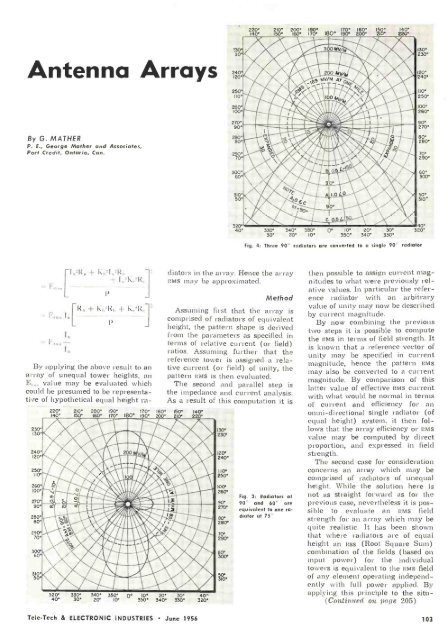TELE-TECH & - AmericanRadioHistory.Com
TELE-TECH & - AmericanRadioHistory.Com
TELE-TECH & - AmericanRadioHistory.Com
Create successful ePaper yourself
Turn your PDF publications into a flip-book with our unique Google optimized e-Paper software.
-<br />
Antenna Arrays<br />
By G. MATHER<br />
P. E., George Mather and Associates,<br />
Port Credit, Ontario, Can.<br />
?3<br />
3 0<br />
s..,<br />
' 4<br />
220' 210' 200'<br />
140 150° 160' 170' 180° 190'<br />
. MV/ .O'<br />
°.<br />
200<br />
47<br />
4k69-tv/m ,OOM,<br />
160°<br />
00° I21Ó°<br />
140°<br />
220°<br />
30°<br />
230°<br />
;,,11<br />
240<br />
20°<br />
120<br />
tt<br />
240'<br />
250°<br />
V'`<br />
110<br />
260°<br />
100°<br />
ÌÈ1t4!*tIIII<br />
270°<br />
280° al %<br />
`',7°° 111.<br />
.<br />
110°<br />
250°<br />
100°<br />
260°<br />
90°<br />
iC<br />
..<br />
I<br />
280°<br />
1!<br />
..,<br />
70° 290°<br />
,_C ,,'<br />
1.OL0 , 50°<br />
5Ó° 310°<br />
6 90'<br />
0.5L1<br />
320° I<br />
40°<br />
40° 330° 340° 350° 0° 10° 20° 30°<br />
270°<br />
90° fttt<br />
3° 1=.. 3<br />
30° 20° 10° 350° 340° 330°<br />
Fig. 4: Three 90 radiators are converted to a single 90 radiator<br />
-I 2R + hL'I,.'RL -<br />
+<br />
l'<br />
R,, + KIM'. '<br />
.<br />
1:..,. I°L - -<br />
P<br />
I°<br />
..,.-<br />
I°<br />
1:,.1:,. l<br />
By applying the above result to an<br />
array of unequal tower heights, an<br />
Er.,, value may be evaluated which<br />
could be presumed to be representative<br />
of hypothetical equal height ra-<br />
Ir#W--gM<br />
220° 210° 200° 190 170° 160' 150° 140<br />
140 150' 160° 170° I 0° 190° 200' 210 220°<br />
.tail 240.®. O<br />
120<br />
250e.'/,<br />
41<br />
PA" ;<br />
llló __/:.<br />
26<br />
..Ioo<br />
.1<br />
4r;?-<br />
2e0°<br />
°<br />
s....<br />
/111;"1111<br />
óí<br />
320° 330' 340° 350° 0° 10° 20' 30' 40'<br />
40' 30° 20' 10' 35011 340' 330° 320°<br />
"?P* /<br />
iIP4<br />
Tele -Tech & ELECTRONIC INDUSTRIES June 1956<br />
J<br />
diators in the array. Hence the array<br />
aMS may be approximated.<br />
Method<br />
Assuming first that the array is<br />
comprised of radiators of equivalent<br />
height, the pattern shape is derived<br />
from the parameters as specified in<br />
terms of relative current (or field)<br />
ratios. Assuming further that the<br />
reference tower is assigned a relative<br />
current (or field) of unity, the<br />
pattern RDAs is then evaluated.<br />
The second and parallel step is<br />
the impedance and current analysis.<br />
As a result of this computation it is<br />
130°<br />
230°<br />
120'<br />
240°<br />
no°<br />
250°<br />
100'<br />
260'<br />
90°<br />
270'<br />
eó°<br />
70°<br />
290'<br />
3o<br />
Fig. 3: Radiators at<br />
90' and 60 are<br />
equivalent to one radiator<br />
at 75<br />
then possible to assign current magnitudes<br />
to what were previously relative<br />
values. In particular the reference<br />
radiator with an arbitrary<br />
value of unity may now be described<br />
by current magnitude.<br />
By now combining the previous<br />
two steps it is possible to compute<br />
the RMS in terms of field strength. It<br />
is known that a reference vector of<br />
unity may be specified in current<br />
magnitude, hence the pattern RMS<br />
may also be converted to a current<br />
magnitude. By comparison of this<br />
latter value of effective Rids current<br />
with what would be normal in terms<br />
of current and efficiency for an<br />
omni -directional single radiator (of<br />
equal height) system, it then follows<br />
that the array efficiency or RMS<br />
value may be computed by direct<br />
proportion, and expressed in field<br />
strength.<br />
The second case for consideration<br />
concerns an array which may be<br />
comprised of radiators of unequal<br />
height. While the solution here is<br />
not as straight forward as for the<br />
previous case, nevertheless it is possible<br />
to evaluate an RMS field<br />
strength for an array which may be<br />
quite realistic. It has been shown<br />
that where radiators are of equal<br />
height an ass (Root Square Sum)<br />
combination of the fields (based on<br />
input power) for the individual<br />
towers is equivalent to the RMS field<br />
of any element operating independently<br />
with full power applied. By<br />
applying this principle to the situ -<br />
(Contitwed on rage 205)<br />
103
















